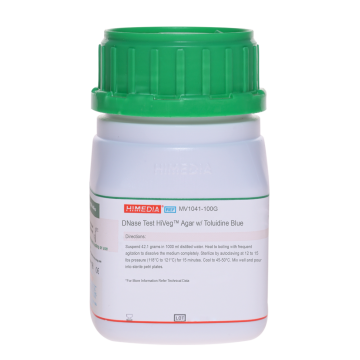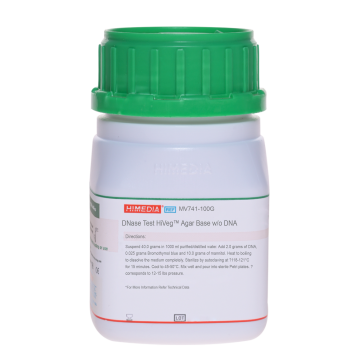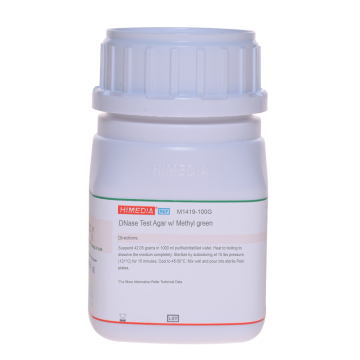 Your enquiry has been submitted
Your enquiry has been submitted
DNase Test Agar w/ Toluidine Blue
Intended use
Recommended for the detection of deoxyribonuclease activity of bacteria and fungi, and especially for identification of Staphylococci.
Composition**
| Ingredients | Gms/Litre |
|---|---|
| Tryptose | 20.000 |
| Deoxyribonucleic acid (DNA) | 2.000 |
| Sodium chloride | 5.000 |
| Toluidine blue | 0.100 |
| Agar | 15.000 |
Final pH (at 25°C): 7.3±0.2
**Formula adjusted, standardized to suit performance parameters
Directions
Suspend 42.1 grams in 1000 ml purified / distilled water. Heat with frequent agitation to dissolve the medium completely. Sterilize by autoclaving at 118°C to 121°C for 15 minutes. Cool to 45-50°C. Mix well and pour into sterile Petri plates.
Principle And Interpretation
DNase Test Agar w/ toluidine blue is used for detecting deoxyribonuclease activity of bacteria and fungi and particularly for identification of pathogenic Staphylococci. With added toluidine blue, it is used in differentiation and identification of non-pigmented Serratia species isolated from clinical sources that might be improperly identified as Enterobacter and Klebsiella species. DNase activity was observed by Weckman and Catlin (8) in Micrococci and found the correlation with coagulase activity as coagulase positive species were DNase positive. Di Salvo (2) confirmed the results of Weckman and Catlin and observed accurate correlation of DNase and coagulase activity. In his experiment Di Salvo incorporated DNA and calcium chloride to activate DNase enzyme. Schreier modified DNase medium by adding toluidine blue (6). Modified medium achieved faster identification of Serratia marcescens and could differentiate Serratia from other members of the Enterobacteriaceae
Tryptose provide essential nutrients. DNase depolymerizes the DNA resulting in the formation of a clear zone around the microbial growth which is visualized by flooding the plate with hydrochloric acid (7).
When toluidine blue is added to the medium itself, DNase activity results in the production of a bright pink reaction due to the metachromatic property of toluidine blue. Some strains of Staphylococci may be inhibited on DNase Test Agar due to toluidine blue.
Type of specimen
Food and dairy samples.
Specimen Collection and Handling
For food and dairy samples, follow appropriate techniques for sample collection and processing as per guidelines (1,5,9). After use, contaminated materials must be sterilized by autoclaving before discarding.
Warning and Precautions
Read the label before opening the container. Wear protective gloves/protective clothing/eye protection/ face protection. Follow good microbiological lab practices while handling specimens and culture. Standard precautions as per established guidelines should be followed while handling specimens. Safety guidelines may be referred in individual safety data sheets.
Limitations :
- Further confirmatory tests for the identification should be carried out.
Performance and Evaluation
Performance of the medium is expected when used as per the direction on the label within the expiry period when stored at recommended temperature.
Quality Control
Appearance: Light yellow to light blue homogeneous free flowing powder
Gelling: Firm, comparable with 1.5% Agar gel
Colour and Clarity of prepared medium: Blue coloured, clear to slightly opalescent gel forms in Petri plates
Reaction: Reaction of 4.2% w/v aqueous solution at 25°C. pH: 7.3±0.2
pH: 7.10-7.50
Cultural Response
Cultural characteristics observed after an incubation at 35 - 37°C for 18 - 24 hours.
| Organism | Inoculum (CFU) | Growth | D-Nase Activity |
|---|---|---|---|
| Serratia marcescens ATCC 8100 | 50-100 | luxuriant | positive reaction, pink to red zone around the growth |
| Staphylococcus aureus subsp.aureus ATCC 25923 (00034*) | 50-100 | luxuriant | positive reaction, pink to red zone around the growth |
| Staphylococcus epidermidis ATCC 12228 (00036*) | 50-100 | luxuriant | negative reaction |
| Streptococcus pyogenes ATCC 19615 | 50-100 | luxuriant | positive reaction, pink to red zone around the growth |
Key: *Corresponding WDCM numbers.
Storage and Shelf Life
Store between 10-30°C in a tightly closed container and the prepared medium at 2-8°C. Use before expiry date on the label. On opening, product should be properly stored dry, after tightly capping the bottle in order to prevent lump formation due to the hygroscopic nature of the product. Improper storage of the product may lead to lump formation. Store in dry ventilated area protected from extremes of temperature and sources of ignition. Seal the container tightly after use. Product performance is best if used within stated expiry period.
Disposal
User must ensure safe disposal by autoclaving and/or incineration of used or unusable preparations of this product. Follow established laboratory procedures in disposing of infectious materials and material that comes into contact with clinical sample must be decontaminated and disposed of in accordance with current laboratory techniques (3,4).
Reference
- American Public Health Association, Standard Methods for the Examination of Dairy Products, 1978, 14th Ed., Washington D.C.
- Di Salvo, 1958, Med. Tech. Bull., U.S. Armed Forces Med. J., 9:191.
- Isenberg, H.D. Clinical Microbiology Procedures Handbook 2nd Edition.
- Jorgensen, J.H., Pfaller, M.A., Carroll, K.C., Funke, G., Landry, M.L., Richter, S.S and Warnock., D.W. (2015) Manual of Clinical Microbiology, 11th Edition. Vol. 1.
- Salfinger Y., and Tortorello M.L. Fifth (Ed.), 2015, Compendium of Methods for the Microbiological Examination of Foods, 5th Ed., American Public Health Association, Washington, D.C.
- Schreir, 1969, Am. J. Clin. Pathol., 51:711.
- Streitfeld, Hoffman and Janklow, 1962, J. Bact., 84:77.
- Weckman and Catlin, 1957, J. Bact., 73:747.
- Wehr H. M. and Frank J. H., 2004, Standard Methods for the Microbiological Examination of Dairy Products, 17th Ed., APHA Inc., Washington, D.C.
| Product Name | DNase Test Agar w/ Toluidine Blue |
|---|---|
| SKU | M1041 |
| Product Type | Regular |
| Physical Form | Powder |
| Origin | Animal |
| Packaging type | HDPE |
| References | 1. Weckman and Catlin, 1957, J. Bact., 73:747. |
| Customized Product Available | No |











